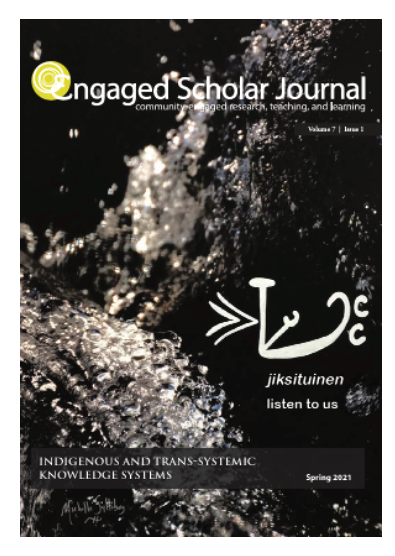Native Americans and Science: Enhancing Participation of Native Americans in the Science and Technology Workforce through Culturally Responsive Science Education
DOI:
https://doi.org/10.15402/esj.v7i1.70770Keywords:
Native Americans, science education, culturally responsive educationAbstract
A major issue that directly affects the participation of Native Americans in the science and technology workforce is the lack of preparation in science and math. This lack of preparation has many causes, but one of the most strategically important issues is the lack of culturally relevant curricula that engage Native American students in learning science in personal, social and culturally meaningful ways. This essay explores the needs, issues, research, and development of culturally responsive science education for Native American learners. A curriculum model created by the author at the Institute of American Indian Arts in Santa Fe, New Mexico, from 1974 to 1994 based on Native American cultural orientations is explored as a case study as one example of how to engage Native American students in science learning and become more prepared to participate in science and technology-related professions. As such, it presents a methodology for how trans-systemic work might be approached in building conceptual bridges between Indigenous and Western views of science.
References
Aikenhead, G. (1997). Toward a First Nations cross-cultural science and technology curriculum. Science Education, 81, 217-238.
Aikenhead, G., & Mitchell, H. (2011). Bridging cultures: Indigenous and scientific ways of knowing. Pearson Canada.
Bohm, D. (1983). Wholeness and the implicate order. Ark Paperbacks.
Brandt, C. B., & Kosko, K. (2009). The power of the earth is a circle: Indigenous science education in North America. In The World of Science Education (pp. 389-407). Brill Sense.
Burk, N. M. (2007). Conceptualizing American Indian/Alaska Native college students' classroom experiences: Negotiating cultural identity between faculty and students. Journal of American Indian Education, 1-18.
Cajete, G. (1994). Look to the mountain: An ecology of Indigenous education. Kivaki Press.
Cajete, G (1999). Ignite the sparkle: An Indigenous science education curriculum model. Kivaki Press.
Cajete, G. A. (1999). The Native American Learner and Bicultural Science Education. Chapter 6 in: "Next Steps: Research and Practice To Advance Indian Education"; see RC 021 798 URL: https://files.eric.ed.gov/fulltext/ED427908.pdf
Cajete, G. (2000). Native science: Natural laws of interdependence. Clear Light Publishers.
Capra, F. (1982). Turning point. Simon and Shuster.
Costa, V.B. (1995). When science is ‘another world’: Relationships between worlds of family, friends, school, and science. Science Education, 79, 313-333.
Dunn, R. (1983). Learning styles at both ends of the spectrum. Exceptional Children, 49(6). https://doi.org/10.1177/001440298304900602
Greene, R. (1981). Culturallybased science: The potential for traditional people, science and folklore. London: Proceedings of the Centennial Observation of the Folklore Society.
Hall, E.T. (1976). Beyond culture. Anchor Books/Doubleday.
James, K. (Ed.) (2001). Science and Native American communities: Legacies of pain, visions of promise. University of Nebraska Press.
Hennessey, S. (1993). Situated cognition and cognitive apprenticeship: Implications for classroom learning. Studies in Science Education, 22(1), 1-41. https://doi.org/10.1080/03057269308560019
Jenkins, E. (1992). School science education: Towards a reconstruction. Journal of Curriculum Studies, 24, 229-246.
Leshner, Alan. (2011). We need to reward those who nurture a dive: teaching in multiversity of ideas in science. Retrieved from http://chronicle.com/article/We-Need-to-Reward--Those-Who/126591/
Longino, Helen E. (1990). Science as social knowledge: Values and objectivity in scientific inquiry. Princeton, NJ: Princeton University Press.
MacIvor, M. (1995). Redefining science education for Aboriginal students. In M. Battiste & J. Barman (Eds.), First Nations education in Canada: The circle unfolds. (pp.73-98). UBC Press.
Mansfield, R.S. (1978). The psychology of creativity and discovery. Nelson-Hall.
Maruyama, M., & Harkins, M. (1978). Cultures of the future. Mouton.
Medin, D., & Bang, M. (2014). Who’s asking? Native science, western science, and science education. M.I.T. Press.
Milne, B.T. (2017). Dynamics to justify strategies to close the Baccalaureate attainment gap in tribal communities of New Mexico. (Unpublished manuscript). April 27, 2017.
Ovando, C.J., & Collier, V. (1985). Bilingual and ESL Classrooms: Teaching in multicultural contexts. McGraw-Hill.
Phelan, P., Davidson, A., & Cao, H. (1991). Students’ multiple worlds: Negotiating the boundaries of family, peers, and school culture. Anthropology and Education Quarterly, 22, 224-250.
Pomeroy, D. (1994). Science education and cultural diversity: Mapping the field. Studies in Science Education, 24, 49-73.
Read, H. (1945). Education through art. Pantheon Books.
Sanders, D. A. (1986). Teaching creativity through metaphor: An integrated brain approach. Longman.
Van Peursen, C.A. (1981). Creativity as a learning process in the concept of creativity in science and art. Martinus Nijhoff.
Whorf, B.L. (1956). Language, thought and reality. M.I.T. Press.
Zais, R. (1976). Curriculum principles and foundations. Harper & Row.
Published
How to Cite
Issue
Section
License
Authors who publish with this journal agree to the following terms:
- Authors retain copyright and grant the journal right of first publication with the work simultaneously licensed under a Creative Commons Attribution License CC BY 4.0 that allows others to share the work with an acknowledgement of the work's authorship and initial publication in this journal.
- Authors are able to enter separate, additional contractual agreements for the non-exclusive distribution of the journal's published version of the work (e.g., post it to an institutional repository or publish it in a book), with an acknowledgement of its initial publication in this journal.
- Authors are permitted to post their work online (e.g., in an institutional repository or on their website) after the publication of their work in the Engaged Scholar Journal.
- Please note that while every opportunity will be taken to ensure author participation in the editing process, due to time constraints final copyediting changes may be made before publication to ensure APA adherence throughout all submissions.




